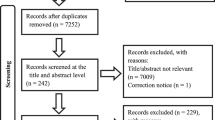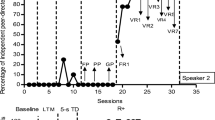Abstract
Picture Exchange Communication Systems (PECS) is a form of augmentative and alternative communication (AAC) frequently used by individuals with autism spectrum disorder and intellectual disability when speech development is delayed or does not develop (Bondy and Frost 1994 in Focus on Autism and Other Developmental Disabilities, 9, 1–19; Sunberg and Partington 1998). Researchers have previously evaluated variations of PECS as a means for vocalization development (Ganz and Simpson 2004 in Journal of Autism and Developmental Disorders, 34, 395–409; Tincani et al. 2006 in Education and Training in Developmental Disabilities, 41, 177–184). The current study investigated delay to reinforcement and an increase in response effort when utilizing PECS on the development of intelligible word vocalizations with four elementary aged students. Three participants transitioned from primarily requesting using PECS at Phase IIIb to using independent vocalizations (i.e., spoken words). This research provides further evidence for the use of PECS not only as a tool for functional communication, but also as a resource for assisting individuals in the development of vocalizations with slight variations in the parameters of reinforcement including response effort and delay of reinforcement.

Similar content being viewed by others
References
Alpern, G. D. (2007). Developmental profile 3 (DP-3). Los Angeles: Western Psychological Services.
Baer, D. M. (1982). The imposition of structure on behavior and the demolition of behavioral structures. In H. E. Howe (Ed.), Nebraska symposium on motivation (vol. 29, pp. 217–254). Lincoln: University of Nebraska Press.
Bernstein, H., & Sturmey, P. (2008). Effects of fixed-ratio schedule values on concurrent mands in children with ASD. Research in Autism Spectrum Disorders, 2, 362–370.
Bernstein, H., Brown, B., & Sturmey, P. (2009). The effects of fixed ratio values on concurrent mand and play responses. Behavior Modification, 33, 199–206.
Blischak, D. M., Lombardino, L. J., & Dyson, A. T. (2003). Use of speech-generating devices: In support of natural speech. Augmentative and Alternative Communication, 19, 29–35.
Bondy, A., & Frost, L. (1994). The picture exchange communication system. Focus on Autism and Other Developmental Disabilities, 9, 1–19.
Bondy, A., & Frost, L. (2001). The picture exchange communication system. Behavior Modification, 25, 725–744.
Buckley, S., & Newchok, D. (2005). Differential impact of response effort within a response chain on use of mands in a student with ASD. Research In Developmental Disabilities: A Multidisciplinary Journal, 26, 77–85.
Carbone, V. J., Sweeney-Kerwin, E. J., Attanasio, V., & Kasper, T. (2010). Increasing the vocal responses of children with autism and developmental disabilities using manual sign mand training and prompt delay. Journal of Applied Behavior Analyis, 43, 705–709.
Cooper, J., Heron, T., & Heward, W. (2007). Applied behavior analysis (2nd ed.). Columbus: Pearson Prentice Hall.
Frost, L., & McGowan, J. (2011). Strategies for transitioning from PECS to SGD: Part I. Overview and device selection. Perspectives on Augmentative and Alternative Communication, 20, 114–118.
Ganz, J. B., & Simpson, R. L. (2004). Effects on communicative requesting and speech development of the picture exchange communication system in children with characteristics of autism. Journal of Autism and Developmental Disorders, 34, 395–409.
Ganz, J., Earles-Vollrath, T., Heath, A., Parker, R., Rispoli, M., & Duran, J. (2012). A meta analysis of single case research studies on aided augmentative and alternative communication systems with individuals with autism spectrum disorder. Journal of Autism and Developmental Disorders, 42, 60–74.
Gast, D. L., & Ledford, J. R. (2014). Single case research methodology: Comparison designs. New York: Routledge.
Gevarter, C., O’Reilly, M. F., Kuhn, M., Mills, K., Ferguson, R., Watkins, L., Sigafoos, J., Lang, R., Rojeski, L., & Lancioni, G. (2016). Increasing the vocalizations of individuals with autism during intervention with a speech-generating device. Journal of Applied Behavior Analysis, 49, 17–33.
Mirenda, P. (2003). Towards functional augmentative and alternative communication for students with autism: Manual signs, graphic symbols, and voice output communication aids. Language, Speech, and Hearing Services in Schools, 34, 203–216.
Newman, L., Wagner, M., Knokey, A.M., Marder, C., Nagle, K., Shaver, D., Wei, X., with Cameto, R., Contreras, E., Ferguson, K., Greene, S., & Schwarting, M. (2011). The post-high school outcomes of young adults with disabilities up to 8 years after high school. A report from the National Longitudinal Transition Study-2 (NLTS2). (NCSER 2011–3005). Menlo Park: SRI International.
Schlosser, R. W. (2003). Effects of AAC on natural speech development. In R. W. Schlosser (Ed.), The efficacy of augmentative and alternative communication: Towards evidence based practice (pp. 404–425). San Diego: Academic Press.
Schlosser, R. W., & Wendt, O. (2008). The effects of augmentative and alternative communication intervention on speech production in children with autism: A systematic review. American Journal of Speech-Language Pathology, 17, 212–230.
Schroeder, S. (1972). Parametric effects of reinforcement frequency, amount of reinforcement, and required response force on sheltered workshop behavior. Journal of Applied Behavior Analysis, 5, 431–441.
Sigafoos, J. (2000). Communication development and aberrant behavior in children with developmental disabilities. Education and Training in Mental Retardation and Developmental Disabilities, 35, 168–176.
Sulzer-Azaroff, B., Hoffman, A. O., Horton, C. B., Bondy, A., & Frost, L. (2009). The picture exchange communication system (PECS): What do the data say? Focus on Autism and Other Developmental Disabilities, 24, 89–103.
Sunberg, M. L., & Partington, J. W. (1998). Teaching language to children with autism and other developmental disabilities: Augmentative communication. Concord: AVB Press.
Tincani, M. (2004). Comparing the picture exchange communication system and sign language training for children with autism. Focus on Autism and Other Developmental Disabilities, 19, 152–163.
Tincani, M., Crozier, S., & Alazetta, L. (2006). The picture exchange communication system: Effects on manding and speech development for school-aged children with ASD. Education and Training in Developmental Disabilities, 41, 177–184.
Wodka, E. L., Mathy, P., & Kalb, L. (2013). Predictors of phrase and fluent speech in children with ASD and severe language delays. American Academy of Pediatrics, 131, 1128–1134.
Wong, C., Odom, S. L., Hume, K., Cox, A. W., Fettig, A., Kucharczyk, S., et al. (2014). Evidence-based practices for children, youth, and young adults with autism Spectrum disorder. Chapel Hill: The University of North Carolina, Frank Porter Graham Child Development Institute, Autism Evidence-Based Practice Review Group.
Author information
Authors and Affiliations
Corresponding author
Ethics declarations
Funding
The study was not funded.
Ethical Approval
All procedures performed in studies involving human participants were in accordance with the ethical standards of the institutional and/or national research committee and with the 1964 Helsinki declaration and its later amendments or comparable ethical standards. This article does not contain any studies with animals performed by any of the authors.
Informed Consent
Informed consent was obtained from all individual participants included in the study.
Conflict of Interest
The authors declare that they have no conflict of interest.
Rights and permissions
About this article
Cite this article
Cagliani, R.R., Ayres, K.M., Whiteside, E. et al. Picture Exchange Communication System and Delay to Reinforcement. J Dev Phys Disabil 29, 925–939 (2017). https://doi.org/10.1007/s10882-017-9564-y
Published:
Issue Date:
DOI: https://doi.org/10.1007/s10882-017-9564-y




